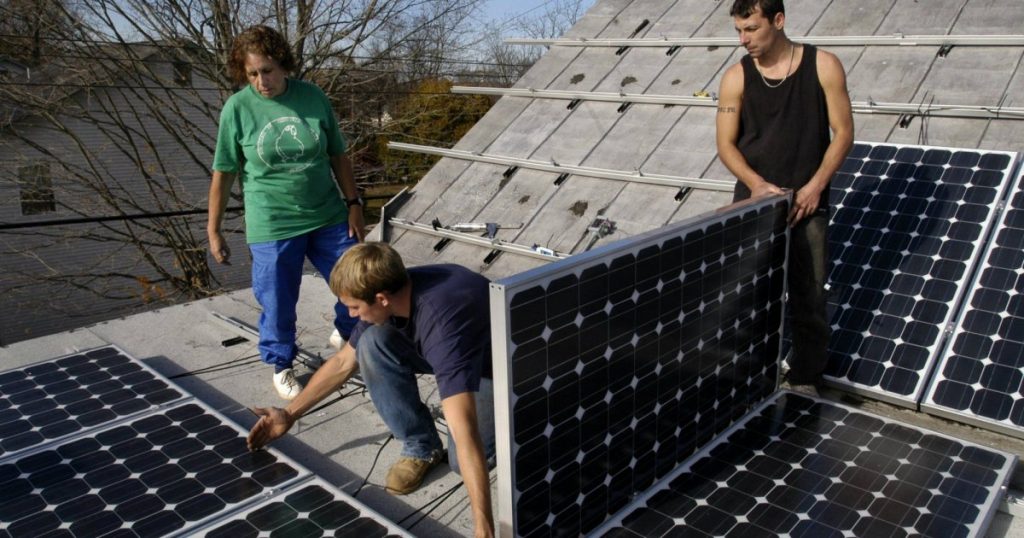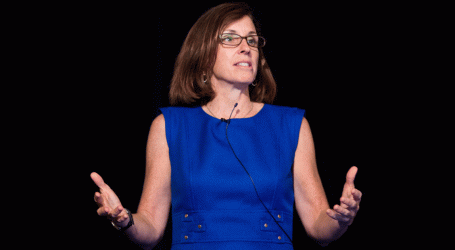Solar Jobs Fell for the First Time in 7 Years in 2017. Now Trump Could Make It Worse.
But on Jan. 22, President Donald Trump approved a 30 percent fee on all imported panels, decreasing by 5 percent per year over four years. The fee was in line with what the International Trade Commission recommended in October, a proposal Suniva called “disappointing” because it was not as aggressive as what the company requested. Still, Suniva and SolarWorld executives “applauded” Trump in a joint statement, and urged him to increase the first-year tariff to 50 percent.
Roughly half of all solar equipment used in the US this year is expected to come from overseas. The new fees are forecast to send solar installations plummeting by 11 percent over the next five years, according to GTM Research, a renewable energy market data firm. Bloomberg New Energy Finance projected solar deployments to drop by 5 percent over seven years, owing to a predicted uptick in construction after the four-year tariff expires. But the previous rate of job growth is unlikely bounce back, as solar companies seek new ways to cut costs as panel prices rise.
“There will be a recovery in how much solar is built and deployed. However, that won’t necessarily translate into jobs in the same way it has in the past,” Hugh Bromley, a solar analyst at Bloomberg New Energy Finance, told HuffPost. “The US solar industry is begging for some labor efficiencies to be found to drive costs down to where they need to be to be competitive.”
The Solar Energy Industries Association, a trade group, said the tariffs would lead to 23,000 job losses this year alone in both the solar installation and manufacturing sectors.
“The tariff decision was unfortunate, we were disappointed in it, and it will have an unnecessary negative effect on solar deployment and employment,” Daniel Whitten, a spokesman for the SEIA, told HuffPost. “But in the years ahead solar is going to resume its place as the leading new source of electricity in this country. It’s just unfortunate that it’s been perhaps delayed by this tariff decision.”
The Solar Foundation conducted its survey of 2,389 solar businesses―some of which included various outposts of the same company―in October and November, using the Bureau of Labor Statistics’ methodology to make 59,300 phone calls and send 35,000 emails. At this point, the White House’s impending decision on the trade case hung over the industry, and the survey responses reflect the uncertainty over the ruling, Gilliland said.
Even in anticipation of the decision, the survey projected a 5.2 percent increase in jobs in 2018 to a record 263,293, with a 6.2 percent spike in installation and a 1 percent manufacturing bump.
It’s unclear how much the tariffs will affect those outlooks in 2018, given that many projects have already purchased their building materials. But Gilliland said the fees could hurt all sectors.
“If the prices go up instead of down, which could happen because of the trade case, then we very likely could see a fall off in installation jobs, and potentially even a falloff in manufacturing jobs as their installers are using less of the manufactured goods,” he said.
It’s not all gloomy for the industry, however. Solar jobs increased in the District of Columbia and 29 states in 2017, including Utah, Minnesota, Arizona, Colorado, Pennsylvania, New Jersey and Tennessee. States and cities emerged as vital counterbalances over the past year after Trump announced plans in June to withdraw from the Paris climate accord and proposed slashing funding for renewable energy.
In July, mayors from 1,481 cities representing 148 million people and 41.8 percent of electricity use across the US signed a pledge to go 100 percent renewable by 2035. California vowed to get 50 percent of its electricity from renewables by 2030, and could now hit that target a decade early. New York set the same goal, and New York City Mayor Bill de Blasio announced plans last month to divest a $5 billion stake in fossil fuels from the city’s five pension funds and sue oil companies for damages related to sea-level rise.
The rising tide pulled by cheap, imported solar panels buoyed manufacturing jobs in the US, too, as employment peaked in 2016 abreast of the installation sector. But solar manufacturers warned that the Trump administration’s tariffs could hurt hiring at their factories.
Solar Foundation“What we’re seeing is many of the states are still setting renewable portfolio standards and setting goals for renewable energy,” Gilliland said. “So there’s very strong momentum toward renewable energy.”
Those regional policies caused diversity to increase in some parts of the solar workforce, and fall in others. Black representation climbed nearly 1 percent in 2017, largely due to the growth of jobs in areas with large black populations, such as the District of Columbia and several Southeastern states. But employment of Hispanics and Asians dipped 0.4 percent and 0.7 percent, respectively, as states like California, Texas and Hawaii saw jobs contract in 2017. The number of women employed in solar fell 1.1 percent as jobs decreased in the sales and distribution sector, where most women in the industry work.
The majority of Americans understand global warming is happening, and that humans are causing it, though partisan divides remain stark over how to address greenhouse gas emissions. Solar energy nonetheless enjoys sweeping support, with nine out of 10 US adults in favor of expanding its use, according to a 2016 Pew Research Center poll. Solar capacity around the world is still on track to multiply 14 times over by 2040, a Bloomberg New Energy Finance study found last year.
“Overall the people and the country are very positive toward solar,” Gilliland said. “The long-term outlook is still very strong. But we will feel some headwinds over the next year.”





